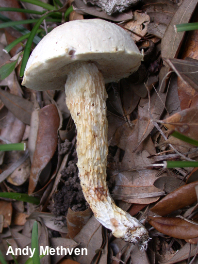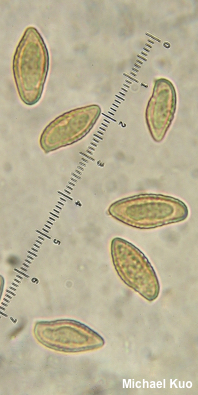| Major Groups > Boletes > Ridged/Pitted-Spored | Tylopilus > Austroboletus subflavidus |

|
Austroboletus subflavidus [ Basidiomycota > Boletales > Boletaceae > Austroboletus . . . ] by Michael Kuo Found in southeastern pine-oak woods, Austroboletus subflavidus is easily distinguished by its pale cap and, especially, its amazing stem. When young, the stem is white, but it soon begins to develop yellow stains and discolorations—and its surface is deeply and coarsely pocketed-reticulate, reminiscent of the stem of Butyriboletus frostii. The pore surface eventually becomes pink, which has led many mycologists over the years to place it with species of Tylopilus. Although microscopic examination is probably not needed to identify Austroboletus subflavidus, its spores are funky and interesting, featuring a finely pimply surface. A recent study (Kuo & Ortiz-Santana 2020) gave tentative support for placement of this species in Austroboletus, since it grouped with Austroboletus dictyotus, the type species of the genus; however, further study of many more collections of closely related species is needed. Thanks to Andy Methven for facilitating study of Austroboletus subflavidus. Description: Ecology: Mycorrhizal with oaks; usually appearing in pine-oak woods; growing alone, scattered, or gregariously; summer and fall; distributed from New Jersey to Florida and Texas; also known from the Caribbean and Central America. The illustrated and described collection is from Georgia. Cap: 6 cm across; convex; tacky; finely velvety; whitish. Pore Surface: Whitish; not bruising; with 1-2 angular pores per mm; tubes to 1 cm deep. Stem: 9 cm long; 1.5 cm thick; more or less equal; whitish, stained pale yellow in places; curved at the base; coarsely pocketed-reticulate; basal mycelium white. Flesh: Whitish overall, but yellow in the stem base; unchanging when sliced. Odor and Taste: Odor not distinctive; taste reported as bitter. Microscopic Features: Spores 15–18 x 6.5–8 µ; boletoid-fusiform; finely pimply-verrucose; dull golden in KOH. Hymenial cystidia scattered and inconspicuous, scarcely projecting; to 35 x 7.5 µm; fusiform; thin-walled; smooth; hyaline in KOH. Pileipellis a collapsing trichoderm of hyaline, smooth elements 5–7.5 µ wide; terminal cells cylindric, with to subclavate rounded apices. REFERENCES: (Murrill, 1938) Wolfe, 1979. (Snell 1941; Singer, 1945; Thiers, 1963; Wolfe, 1979; Weber & Smith, 1985; Phillips, 1991; Both, 1993; Bessette et al., 2000; Ortiz-Santana et al., 2007; Bessette et al., 2016; Kuo & Ortiz-Santana, 2020.) Herb. Kuo 09192002 (portion of ASM 12467). This site contains no information about the edibility or toxicity of mushrooms. |
© MushroomExpert.Com |
|
Cite this page as: Kuo, M. (2020, October). Austroboletus subflavidus. Retrieved from the MushroomExpert.Com Web site: http://www.mushroomexpert.com/austroboletus_subflavidus.html |

